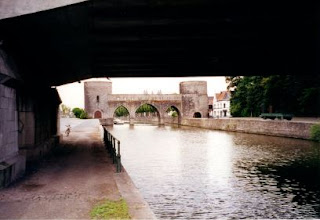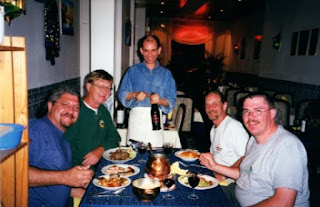This historic city of 70,000, famed for its Cathedrale de Notre-Dame and UNESCO world heritage belfry, possessed no working breweries.*
Furthermore, there was only one specialty beer café, La Cave à Bière**, deemed worthy of mention in the British writer Tim Webb’s essential guidebook of the time, The Good Beer Guide to Belgium and Holland.
Nonetheless, we elected to make Tournai our home for the first three days of the inaugural biking and beer-hunting Belgian holiday, a choice primarily reflecting the city's relative proximity to top-flight breweries in the countryside. Also, our choice of accommodations, the Hotel d’Alcantara, had inexpensive bicycles available for use in reaching these beer places.
Just how inexpensive soon became apparent.
We never regretted those Tournai days. Apart from brewery proximity, the city proved intriguing in its own right. Founded as a Roman settlement, Tournai was ceded, regained, swapped and passed around between various feudal and imperial powers for much of its history. The vibe was relaxed, with a pleasing mixture of new and old Europe.
Tournai suffered damage in both of the 20th-century’s European conflagrations, and in World War II, it had the distinction of being the first Belgian city to be liberated from the Nazis. In addition to the cathedral and belfry, there were plenty of shadowy back streets to explore, as well as the Escaut River's eclectic pathway through the city, which included a squat, massive 13th-century bridge we found fascinating.
The otherwise attractive Grand Place (central square) seemed to function primarily as a huge car park, though it had a strange on-again, off-again sidewalk fountain made possible by European Union economic development funds.
 |
| Photo credit. |
(My last visit to Tournai came in 2004. What's it like now?)
Roughly ten miles west of Tournai is the French city of Lille. We didn’t have time to visit Lille in 2000, but it was considered a center of northern French brewing even then, with many beer bars in the city center and breweries in its outskirts. I'm told it's only gotten better since.
The rural Brunehaut brewery is located ten miles south of Tournai; it dates from 1992 and makes several fine ales available locally and throughout Belgium. One beer that stood out from the rest was a specialty Brunehaut ale spiked with Genever, a distilled counterpart to gin, and indigenous to the Low Countries.
Twenty miles northeast of Tournai is the region known as the Pays du Collines, which is a rural area of low hills, towns, patches of woods, farms, and a recently renewed focus on ecotourism. With the invaluable assistance of a Hotel d’Alcantara staffer, we booked a guided mountain bike tour of the Pays du Collines for our second day in town.
Most importantly, ten miles east of Tournai there is an amazing concentration of classic, small breweries, each just a few kilometers from the others: Dubuisson, maker of the incredible Bush strong ale (known as Scaldis in the USA); Dupont, brewer of classic Saison ales; and Vapeur, the archaic steam-powered museum/brewery scheduled for a visit on Day Three.
Before mountain biking Friday and brewery schmoozing Saturday, there was an open biking day Thursday. We had plenty of raw adrenaline, but not much of a plan. Having examined the four bikes and found them to be rickety but serviceable, we chatted with the friendly hotel manager, who suggested charting a course for Mont St. Aubert, a few miles north of Tournai. This choice seemed as good as any, so we followed the manager’s directions.
Along the way, our quartet received an introduction to the joys of biking and bruising over dry cobblestone streets; wet cobblestones were yet to come and provided thrills of an even greater magnitude. These gave way to smoother paved roads as we left the inner city area and entered the more modern districts on the outskirts.
Following signs into the countryside, the hill could be seen clearly, looming ahead of us. Climbing it was a challenge, with each of us having only a handful of gears in operating condition, but we made it to the top and were rewarded with a spectacular view of Tournai and the surrounding region.
Actually, some of us made it in better condition than others. When you see Buddy Sandbach at the Public House, ask him the French pronunciation of “Ralph.”
Curiously, it’s almost the same as the American.
Bob Reed had thoughtfully procured a map of the area, and using it we rode off on country lanes, through the surrounding farmlands and their reassuring aromas of fodder and dung, eventually coming to the town of Pecq. From there we took immaculately groomed bike paths along the river back into Tournai.
It was unlikely that we rode more than 15 miles all day, but the historical significance of this inaugural bicycling foray simply cannot be exaggerated.
It didn’t matter at all that the bicycles were inferior. During the course of European travels dating back to 1985, I’d traveled by rail, bus, boat, automobile, and on foot. All of the previous experiences were special in their own way, but in the year 2000 – for the first time in years – I felt exhilaration and the pure joy of discovery. Perhaps rediscovery is a better word.
Kevin Richards and I had talked about it for months, and now we’d done it, and I immediately understood. I was hooked. Puffing up Mont St. Aubert, I knew Europe would never be the same for me.
We were judicious and kept the ride short the first day, devoting the remainder of the afternoon to walking through town, pausing to have a restorative ale in the street level café of the Hotel Europ (Bush Blonde, an easy-drinking, elegant 10.5% ale), then dining on beefsteak and fries at a nearby restaurant.
The aforementioned La Cave à Bière, then considered Tournai’s finest specialty beer café, opened at 5:00 p.m.
La Cave à Bière was revealed to be a variant of the “shotgun” bar, filling space below street level mere yards from the river in a venerable old European warehouse. The walls and vaulted brick ceiling were painted white, with a small bar, big wooden tables and chairs lining both sides of a central walkway, and Belgian brewing memorabilia nailed everywhere.
The café appeared to be run by a male head waiter and a female chef, perhaps husband and wife, perhaps not, but with the latter being firmly in charge of the proceedings. In addition to a bottled beer list of 75 to 100 choices, there were typical Belgian café snacks, and as we were to discover on Saturday evening, tasty full meals on weekends.
Settling in, I concentrated on regional ales: Brunehaut, Quintine and Dupont. Vapeur was available, but there’d be plenty of that on Saturday at the monthly brewing day in Pipaix.
On Friday morning following an exemplary hotel breakfast, it was time for yet another new adventure. Etienne, a teacher, coach and superbly conditioned all-around athlete, loaded us into his pristine van for the trip to the rural Pays du Collines for the day’s mountain biking excursion.
At a sparkling new athletic club in a town on the periphery, we were introduced to our snazzy fat-tired bikes and met Etienne’s bubbly aunt, who would be following us in her car and stopping occasionally to provide commentary in English.
Etienne confessed to speaking only French, but as usually is the case in such times, we were able to communicate wonderfully through gestures and snippets. With regard to mountain biking technique, Etienne showed us what to do, and we followed his lead.
Off we pedaled into the beautiful natural area for an unforgettable day. For Bob, Buddy and I, it was a first-time experience on a mountain bike, off-road in the rough – over steep hills in the mud, across dirt paths in wide, cleared fields, and through old railroad cuts in the woods. Kevin and Etienne bonded immediately, finding a common language in their love of sporting endeavors.
Along the way we stopped at a traditional farmstead to view an old mill under restoration, and visited a museum of local culture for an exhibit telling the story of the small workshops once common to Hainaut province, which made products like wooden shoes.
Two hours into the ride, Etienne took us to his mother’s rectangular brick farmstead for juice, coffee and pastries. Later, in the village of Ellezelle, there was a much appreciated re-hydration sag at the Brasserie Ellezelloise.
At the time of our visit to the isolated country micro/brewpub, its high quality ales in stopper bottles all were brewed in-house. Since then, production has been transferred to Brasserie Des Légendes, a brewery nearby. Hercule, an intense, high-gravity sweet stout named for fictional detective Hercule Poirot, remains the pick of the litter.
Etienne took care to point us in the direction of Ellezelle's pay-to-spray witch, squatting atop a waist-high pedestal, a regional symbol often compared to the Mannekin-Pis in Brussels by virtue of its ... plumbing. On normal days, one puts coins into the adjacent slot, and if you're unlucky, only water comes shooting out from beneath the witch’s skirt … but during magical times, beer flows instead -- or so we were told.
Just remember to bring a cup in case of magic.
At the end of the afternoon, we retired to the posh local club within the athletic complex and drank a round of Hoegaardens to Etienne, a superlative guide and true gentleman.
How many YMCAs in America even have bars?
For a second consecutive evening back in Tournai, the consensus choice for dinner was couscous (kews-kews), the North African ethnic delight as widely available in Tournai as Chinese or Mexican is in Southern Indiana.
Perhaps it should be noted at this juncture that my newfound joy in biking was not accompanied by unnecessary restrictions such as dieting or moderation in drinking.
After all, the whole point in riding hard during the day was justifying massive meals and fine ale at night. Thus acknowledged, couscous proved to be ideally suited for an exercise regimen like ours. The tiny rice-like granules are in fact pasta; grilled sausages and skewered meats accompany the rich vegetable-based sauce, all of it uniquely spiced and smothered with fiery harissa sauce. Chickpeas and pine nuts appear alongside raisins and dates.
The red wine? Also memorable, and proof of our versatility.
Finally returned to the hotel and sated, with a final round of ales safely beneath our belts, we slept well.
Saturday would be the highlight of the Tournai segment of the trip. There'd be a ride to and from the monthly brewing day at Brasserie à Vapeur (the steam-operated brewery), followed by televised Eurocup soccer in Tournai, then a special meal of lobster at the La Cave à Bière, and best of all, the delightful company of three dear friends from Denmark: Kim Andersen, Kim Wiesener, and Allan Gamborg. They were in Belgium for the Eurocup, and had booked rooms at the a’Alcantara to meet us for one evening’s dining and drinking.
Next: Would the novice beercycling team survive these rigors?
---
* It appears that a brewpub exists there today.
** There seem to be no on-line references to La Cave à Bière since around 2013, which suggests that it's no longer in business.
__





















No comments:
Post a Comment